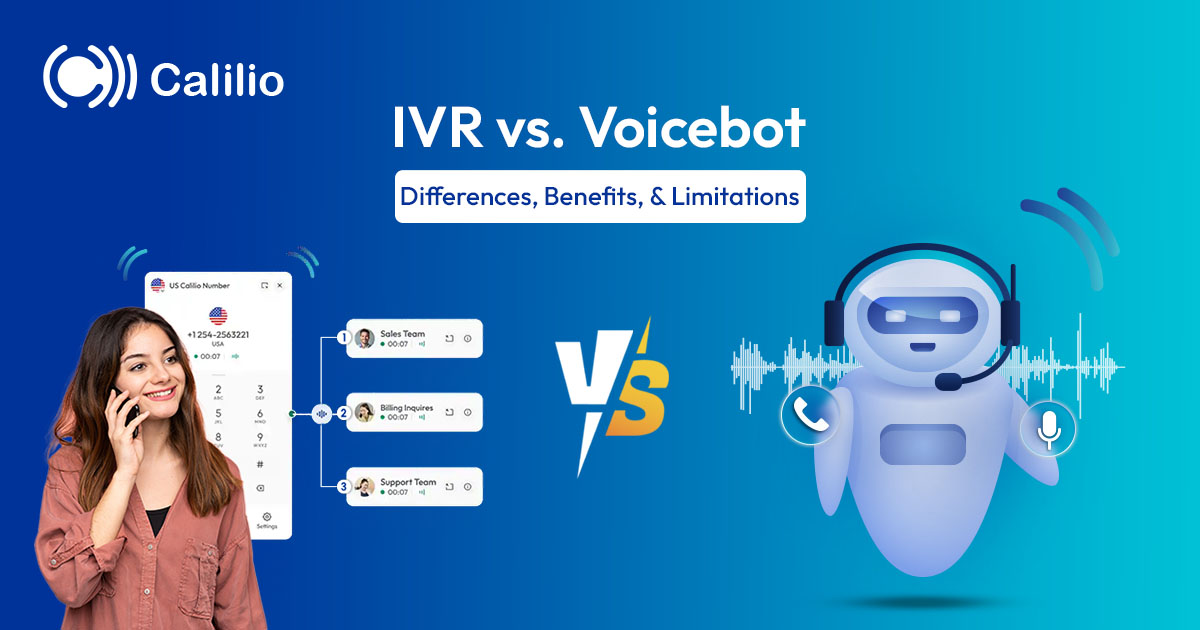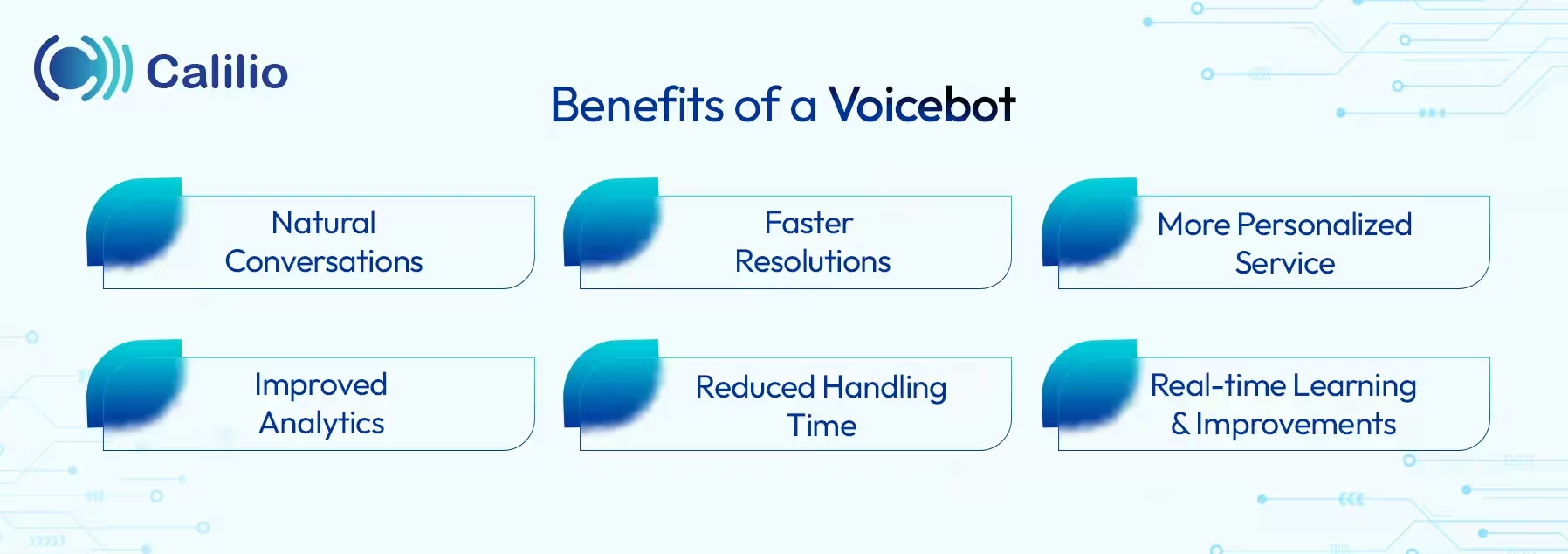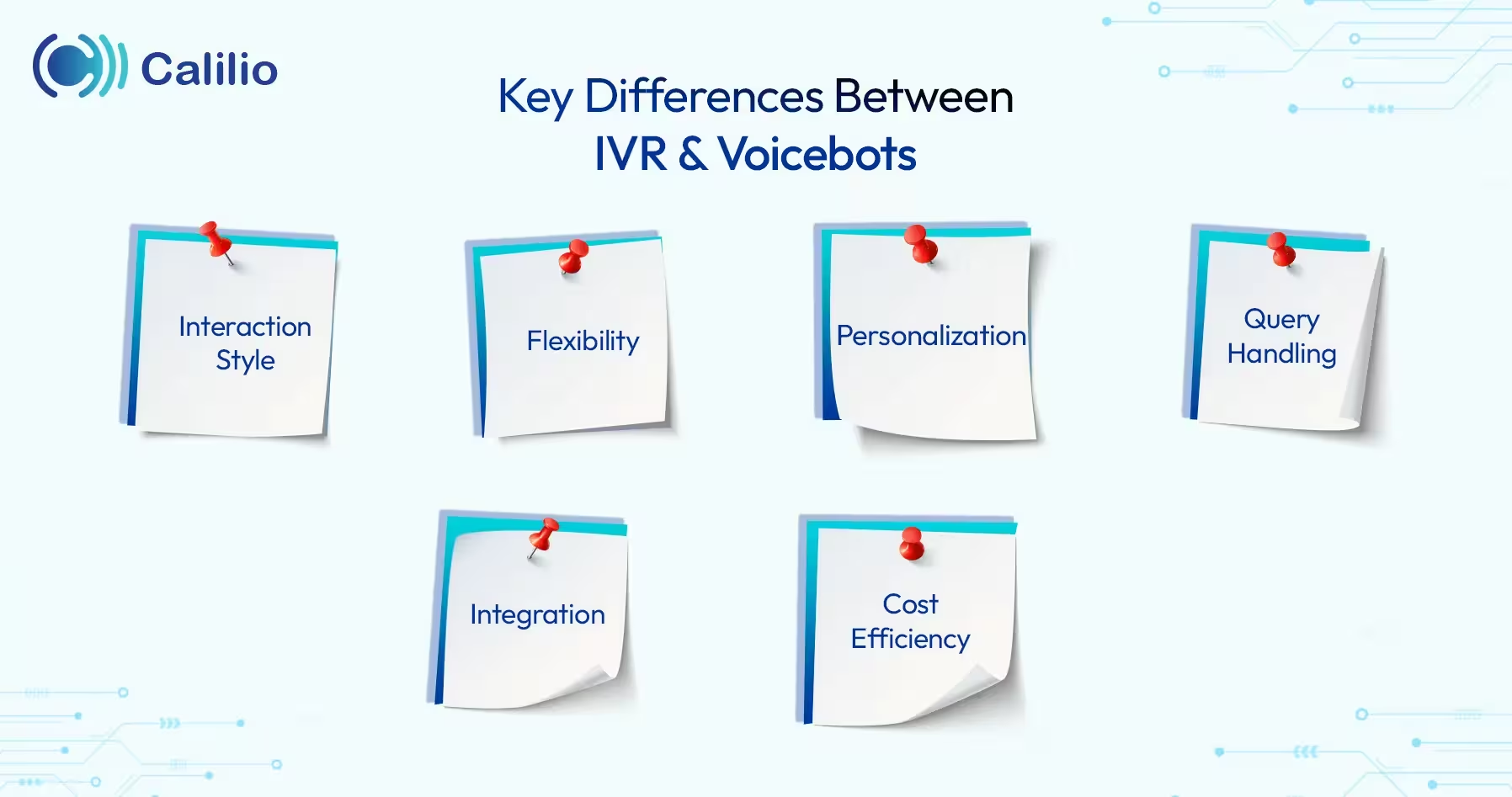IVR vs. Voicebot: Which One is Right for Your Business?

Businesses often handle a steady stream of customer calls, whether it’s about billing, orders, or support. Customers expect quick answers, but traditional systems can leave them frustrated with long wait times and complicated menus, leading to poor customer satisfaction, inefficiencies and higher costs.
To solve the challenge of handling customer calls efficiently, businesses are turning to voice automation technologies like IVR and Voicebots. IVR uses simple menus to manage calls, while Voicebots use AI to offer smarter, more personalized interactions. Choosing between IVR and Voicebots can be tricky without understanding both technologies for your business.
This guide will break down the key differences between these solutions and help you choose the right approach to streamline your customer interactions.
Key Highlights:
IVR is an automated system that uses pre-recorded menus and keypad inputs to route calls or provide basic self-service.
Voicebot is an AI-powered assistant that understands natural speech, processes intent, and responds in a conversational way.
IVR is best suited for simple, repetitive queries like balance checks or call routing, while voicebot offers natural conversations with personalization and real-time learning.
IVR has a lower setup cost, while voicebots tend to be costlier because they rely on natural language processing, machine learning, and system integrations.
Voicebots connect to CRMs and APIs, unlike traditional IVR.
What is IVR?
Interactive Voice Response (IVR) is an automated telephony system that allows businesses to interact with callers using pre-recorded voice menus and keypad inputs. Instead of immediately speaking to a human agent, customers listen to voice prompts and make selections (e.g., “Press 1 for Sales, Press 2 for Support”) to route their call or access self-service options.
In short, IVR acts as the frontline of customer service, helping businesses manage high call volumes, reduce agent workload, and guide customers to the right solutions efficiently.
How Does It Work?
IVR delivers pre-recorded messages and takes input through keypad inputs (DTMF tones) to guide callers through a structured menu. Here’s the step-by-step flow:
- Call Initiation: A customer dials your business number and initiates the call.
- Greeting and Menu: The IVR system plays a recorded greeting, followed by menu options (e.g., “Press 1 for Technical Support, Press 2 for Billing”).
- User Input: The caller responds by pressing numbers on their keypad.
- System Processing and Call Routing: Based on the input, the IVR system either:
- Routes the call to the correct agent or department.
- Provides self-service options, such as checking account balances or order status, without the need for a live agent.
- Resolution: The caller either resolves their query through self-service or is connected to the right support representative.
Benefits of IVR
IVR systems offer cost-effective solutions by automating repetitive tasks, handling high call volumes, and providing 24/7 access to basic information. They efficiently route calls to the right department and offer self-service options, improving response times and customer satisfaction.

- Cost-effective: It reduces the need for large customer support teams by automating repetitive interactions.
- High Call Volumes: It can route multiple calls simultaneously without overloading human agents.
- 24/7 Availability: Customers can access basic information anytime, even outside business hours.
- Efficient Call Routing: It directs callers to the right department quickly, improving response times.
- Self-Service Options: Customers can check balances, track orders, or get FAQs answered without speaking to an agent.
Limitations of IVR
While IVR systems help reduce call volumes and route customers efficiently, they also bring challenges. The fixed menus can create rigid experiences, and lengthy navigation often frustrates callers. In addition, the lack of personalization and AI-driven learning limits flexibility, which in turn increases the risk of high abandoned calls.
- Creates a Rigid Experience: Customers must follow fixed menus, which often feel restrictive compared to natural conversations.
- Frustrate Customers: Multi-level IVR with lengthy menus confuses callers, leading to frustration and poor experiences.
- Provides Limited Personalization: The system cannot tailor responses to individual customer needs or preferences.
- Lacks AI Capabilities: Unlike modern voicebots, traditional IVR does not learn or improve over time through customer interaction.
- Increases the Risk of Call Drop-offs: Customers may abandon calls if they cannot quickly find the right option.
Upgrade Your Business Phone System with Calilio’s Smart Ivr. Automate, Route, and Respond Faster!
What is a Voicebot?
A Voicebot is an AI-powered conversational assistant that interacts with users through spoken language. Instead of typing in a chatbot, users talk to the system, and it responds with speech.
Voicebots use Automatic Speech Recognition (ASR), Natural Language Processing (NLP), and Text-to-Speech (TTS) technologies to understand speech, process the meaning, and respond in a natural voice.
Examples: Siri, Alexa, Google Assistant, or customer service bots in call centers.
Benefits of a Voicebot
Voicebots enable natural conversations, making interactions quicker and more intuitive. It delivers personalized service while advanced analytics and real-time learning ensure continuous improvement and faster resolutions.

- Natural Conversations: A voicebot lets people speak naturally, like they are having a conversation, making the interaction faster and easier than IVR.
- Faster Resolutions: It can understand the intent right away and guide the caller directly with a solution instead of multilevel options.
- More Personalized Service: Voicebots connect to systems like CRM to recognize callers and use their history for customized interactions.
- Improved Analytics: Voicebots capture data from every interaction and help businesses identify customer trends, patterns, and areas that need improvement.
- Reduced Handling Time: With personalized interactions and advanced analytics, voicebots can quickly understand customer needs and provide instant answers without long wait times.
- Real-time Learning and Improvements: With continuous training through real-time interactions, voicebots can learn and improve their answering services over time.
How Does a Voicebot Work?
A voicebot listens to a user’s speech, converts it into text, and interprets the intent using AI and NLP. It then retrieves the required information and responds through text-to-speech, creating fast and natural, human-like conversations. The process typically involves these steps:
- Speech Input: The user speaks into a device (phone, smart speaker, IVR line, etc.).
- Speech Recognition (ASR): The spoken words are converted into text.
- Natural Language Understanding (NLU/NLP): The system analyzes the intent and extracts meaning.
E.g., “I want to check my balance”, NLP recognizes “check” as the action and understands that the user intends to check their balance. - Processing and Integration: The bot connects to databases, CRM systems, or APIs to fetch information or perform actions.
- Response Generation: The system generates an appropriate reply.
- Text-to-Speech (TTS): The reply is converted into a synthetic but natural-sounding voice.
- Speech Output: The response is sent back to the user as a voice.
Limitations of Voicebots
While voicebots overcome the limitations of IVR and offer natural conversations along with faster resolutions, they have their own set of challenges. Some of them are as follows:
- Technical Integration: Voicebots can be complex and time-consuming to integrate with existing systems, CRMs, ERPs, etc.
- Accuracy Issues: Speech recognition and machine learning models are not always precise, which leads to misinterpretations of user input.
- Context Handling: Many bots struggle to remember details across multiple exchanges, breaking the flow of conversation.
- Customer Expectations: Many callers don’t like to interact with a voicebot. Users often expect human-like interaction, and voicebots may feel rigid or limited by comparison.
- Multilingual Support: Voicebots often struggle with less common languages, regional accents, and code-switching because speech recognition and NLP models are usually trained on limited datasets.
Key Differences Between IVR & Voicebots
IVR offers a simple, menu-based system that’s cost-effective for basic tasks but rigid, impersonal and limited in handling complex queries. In contrast, voicebots use AI and NLP to enable natural conversations, offer personalization, and integrate seamlessly with business systems, and scale more effectively.
1. Interaction Style
IVR systems rely on a fixed, menu-driven approach where callers must press keys or use limited voice commands to navigate options. In contrast, voicebots use conversational AI and natural language processing, allowing customers to speak freely in their own words and still be understood, improving the customer experience.
2. Flexibility
IVR is rigid, offering only pre-programmed paths that cannot easily adapt to new inputs or scenarios. Voicebots, on the other hand, are dynamic and can learn from interactions over time, improving their ability to understand and respond to varied customer queries.
3. Personalization
With IVR, every customer experiences the same standard menu and responses, making it feel impersonal. Voicebots provide a more human-like touch by personalizing conversations, drawing on customer data, history, and context to tailor the interaction.
4. Query Handling
IVR works best for simple and repetitive requests, such as checking balances, paying bills, or routing calls. When conversations become more complex, however, IVR often falls short. Voicebots are better equipped to handle multi-turn dialogues, clarifications, and complex queries smoothly.
5. Integration
Traditional IVR systems generally operate in isolation and have limited integration with other platforms. Voicebots, however, can seamlessly connect with CRMs, knowledge bases, and APIs, enabling them to provide more thoughtful, more informed responses in real time.
6. Cost Efficiency
IVR is usually cheaper to set up initially, making it attractive for basic use cases. But as customer needs grow and menus expand, maintenance costs rise. Voicebots may require a higher upfront investment, but they deliver greater long-term value through automation, adaptability, and improved customer satisfaction.
Here’s a side-by-side comparison between IVR and a voicebot:
Aspect | IVR | VoiceBot |
| Interaction Style | Fixed menus guide callers, and the system takes keypad inputs. | Conversational, understands natural speech. |
| Types of Calls | Primarily used for inbound calls only. | Handles both inbound and outbound calls. |
| Flexibility | Static workflows that require manual updates. | Adaptive and improves through AI learning. |
| Personalization | Offers the same standard responses to all callers. | Tailors conversations using customer context and history. |
| Query Handling | Suited for straightforward query and call routing only. | Manages complex, multi-step queries naturally. |
| Integration | Limited backend connectivity. | Connects seamlessly with CRMs, APIs, and databases. |
| Learning Capability | Does not learn from the interactions. | Analyzes and improves through interactions over time. |
| Cost Efficiency | Lower initial setup, but costly to scale and maintain. | Higher upfront investment with more substantial long-term ROI. |
| Scalability | Limited scalability. | Easily scalable without significant resources. |
Which One is Right for Your Contact Center?
Choosing between IVR and voicebots depends on your business needs, customer expectations, and budget. If your organization mainly handles high volumes of simple, repetitive queries such as balance checks, appointment confirmations, or call routing, a traditional IVR system may be sufficient and cost-effective in the short term.
However, if your customers expect faster, more natural conversations and your business requires handling complex queries, voicebots are a better option.
In many cases, businesses adopt a hybrid approach, where IVR manages straightforward tasks, while voicebots take over when natural, contextual interactions are needed. Contact centers can use the hybrid approach, like Conversational IVR and AI-enabled IVR with the intelligence of a voicebot, helping balance the organization’s control costs while delivering modern, customer-friendly service.
Conclusion
IVR and voicebots each play distinct roles in customer communication. IVR is best for structured, high-volume interactions like routing calls, sharing information, and reducing wait times. Voicebots, on the other hand, offer more flexibility for conversational engagement. Many businesses use IVR as the foundation of their call handling strategy, upgrading to advanced tools only when their needs expand.
With Calilio, you can set up an intelligent IVR system that automates call routing, provides self-service options, and improves response times—all without complex integrations. Its features, like call forwarding, call transfer, and customizable IVR menus, help direct callers to the right person quickly, reduce wait times, and provide 24/7 support to keep customers satisfied.
Your Phone System Just Got Cheaper
Virtual numbers from just $2/month
Call rates starting as low as $0.016/min
The most cost-effective VoIP phone system for businesses
Powered by advanced AI telephony features
Compare low-cost business phone systems
Frequently Asked Questions
Is IVR still relevant?
Yes, IVR is still relevant because it’s affordable, reliable, and effective for managing high call volumes with straightforward queries.
How does a voicebot work?
Is IVR considered an AI?
What is the difference between AI and IVR?

Still have questions?
Can’t find the answer you’re looking for? Please chat with our friendly team.
Stay in the loop
Get the latest call insights, trends, and updates delivered straight to your inbox.
By subscribing, you agree to receive updates from Calilio.
You can unsubscribe anytime.
Phone numbers
Get International Phone Numbers
Singapore
|Australia
|New Zealand